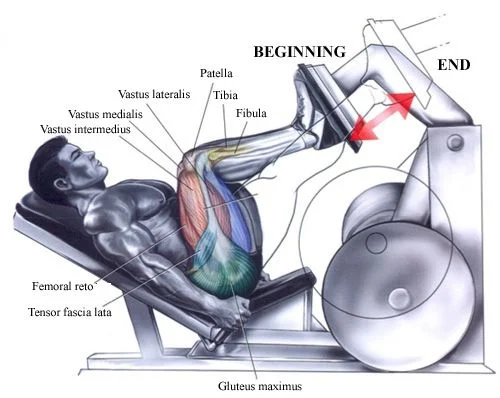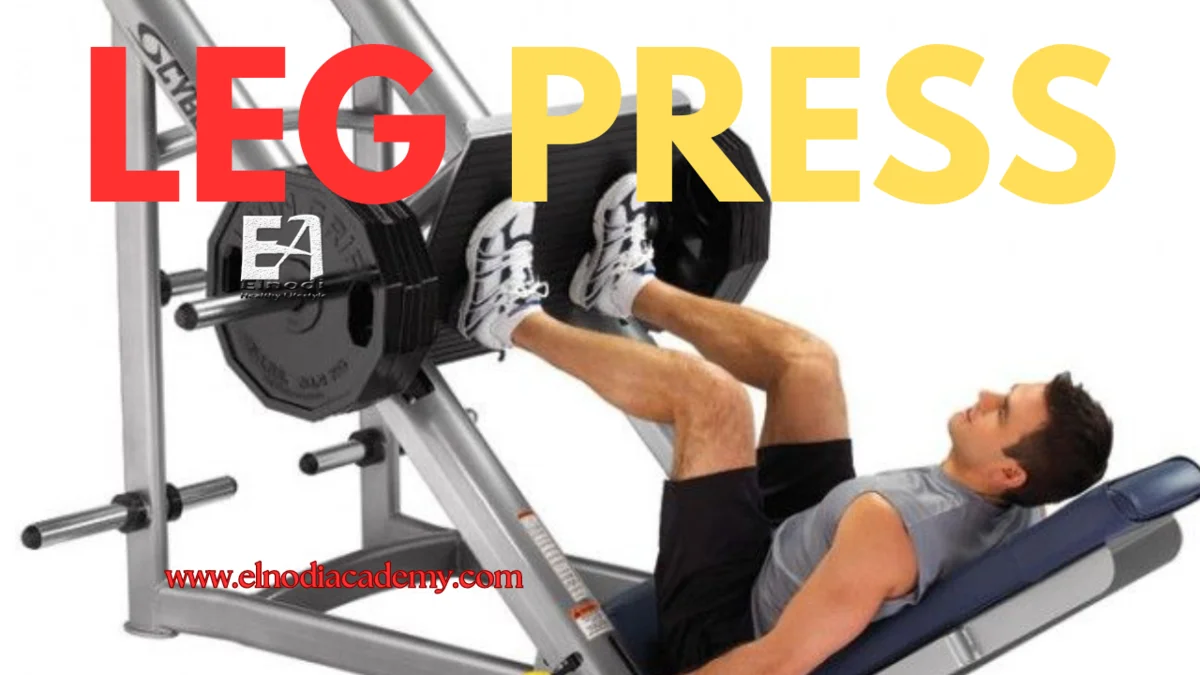The leg press is one of the most popular hi-resistance exercises around because of its ability to stimulate muscle growth both in the amplitude and quality of the contraction. Additionally, research also demonstrates that this workout is a powerful tool for overall fitness improvement.
To maximize the effectiveness of the leg press, make sure to incorporate some of these 5 Best Leg Press Exercises into your regular training routine.
Leg Press Benefits

Build Strength Post-injury
Before returning to training after an injury, consult with a doctor. However, if you’ve been cleared for exercise, the leg press might help you safely return to strength training after a break. (1)
It does not require as much core stability, coordination, or strain on your lower and upper back as a barbell squat. You may begin restoring your strength without putting additional strain on your body.
Increase Quadriceps Development
Chasing teardrop quads? Need more powerful legs to fuel everything from box jumps to stronger squats? Whether your goal is aesthetics, strength, or both, the leg press is your new best accessory workout. (2)
Back and core strength, as well as leg strength, are required to work up to maximum lifts in moves like the back squat and front squat. However, the leg press allows lifters and athletes to target the quadriceps without being hindered by other muscular groups. (3)
Minimize Direct Load in the Back
The leg press allows lifters to lessen spinal loading while still training the lower body. If you want to drastically boost your heavy leg volume without putting strain on your back like a squat or a deadlift, the leg press can help. (4)
Because the backrest and seat will support your entire torso, you won’t have to worry about keeping your core and lower back stable during the lift. And because you won’t be carrying a loaded barbell in your hands (deadlift) or on your back (squat), your upper back will benefit as well.
leg press target muscles

Primary muscles worked:
Secondary muscles worked:
- Hamstrings
Leg press form
How to do Leg Press Correctly
Instructions
- Take a seat and load the machine with the necessary weight.
- Sit down and take a shoulder-width stance with your feet on the sled.
- Take a deep breath, stretch your legs, and unlock the locks.
- Lower the weight gradually until the legs are at or slightly below 45 degrees.
- Extend the knees to drive the weight back to the starting position without locking out.
- Repeat until the desired number of repetitions has been reached.
Tips
- To keep tension on the quads, keep the knees just shy of lockout.
- To emphasize the glutes more, push through the heels.
- Push into the balls of the feet to focus the quads even more.
- Don’t allow the hips to posteriorly tilt and roll off the pad.
- Throughout the action, keep your lower back flat against the pad.
- Maintain a neutral head position by not looking up or down excessively.
- It is feasible to self-spot by just applying pressure to the knees with the palms. Use only when absolutely necessary.
- The toe angle is individual and will depend upon each individual’s hip anatomy and ankle mobility – experiment and adjust based on feel.
Common Mistakes
Too Much Weight
One of the most important things to remember is to avoid lifting extra pounds. You should. Reduce the weight if you can’t control your motions. The amount of weight you lift is less crucial than proper form.
Buttocks Not Flat Against Seat
Your legs are at an incorrect angle if your buttocks are elevated off the seat. Adjust the seat back until your knees and buttocks are comfortably positioned. Poor placement is noticeable when you feel constricted and/or your knees appear to be directly in front of your eyes.
Placing Hands on Knees
Placing hands on the knees is a common mistake that will break your form. Grip the assist handles instead.
Short Range of Motion
Always move through a complete variety of motions while keeping your hips down. Adjust the seat and/or decrease your weight as needed. This entails getting into a deep position with your buttocks below your hips and your knees wide.
Raising Head
Concentrate on your head position. It should be stable and snug against the seatback. You are utilizing too much weight if you jolt your head forward.
Breathing
Remember to keep breathing during the effort phase and to avoid holding your breath. If you focus on exhaling on exertion and inhaling on release, your breathing will eventually become automatic.
Safety and Precautions
Avoid the leg press if you have weak pelvic floor muscles, as it puts much stress on the pelvic floor.5 You should not use this equipment if you have a knee injury. Instead, do safer leg strengthening exercises as your doctor or physical therapist recommended.
If one or both of your knees are hurting, do not ignore the discomfort. Injury will result if you try to push through. If you have a back injury or back pain, you should avoid doing this exercise because it can put stress on your back.
Leg Press Sets And Reps
- Warm-up: 2 sets of 10-12 repetitions with a lightweight
- Working sets: 3 sets of 10-15 repetitions with a moderate to heavy weight.
- Cool-down: 1 set of 12-15 reps with a lightweight
Leg Press Variations
Banded Leg Press
- Simply wrap a light resistance band around the weight pegs and seat frame of the leg press sled to perform the banded leg press.
- Rep your reps as normal.
1 ½ Leg Press
- To perform, lower the sled to the bottom position as usual.
- Return the sled halfway up.
- Stop at the halfway mark, then lower it back to the bottom.
- Finally, return the sled to its starting position. That is one repetition.
Partial Leg Press
- To do a partial leg press, perform regular leg presses but only within a limited range of motion.
- Staying inside the upper half of the rep (considering 90 degrees as the “bottom” of each rep rather than dropping all the way down) may be necessary. Alternatively, instead of getting to full extension, stay near the bottom of your range of motion and regard the 90-degree position as the “top” of each rep.
- To effectively assault your muscles, perform up to 15 reps per set.
5 Best Ways To Use the Leg Press Machine
1. Basic feet leg press: For total leg growth, space your feet shoulder-width apart.
2. High feet leg press: Placing the feet higher up on the foot pad stimulates the hamstrings and glutes, relieving stress on the quadriceps. This is an excellent alternative to deadlifts and hamstring curls. Most people will discover that they can lift the most weight in this position.
3. Low feet leg press: Placing the feet low on the foot pad completely transfers the exercise’s stress-loading pattern onto the quads. This is the finest squat alternative, however, if you have knee discomfort, take it easy on this one.
4. Wide stance leg press: By bringing you further apart, the emphasis will move on to your inner quad muscles. This move is a similar one to a standard sumo squat.
5. Leg press narrow stance: You will work the outer thigh muscles by moving your feet closer together. The lower your narrow stance is placed, the more quad-dominant this variation will be. However, by placing the feet close together, you will already be putting greater attention on the quad muscles, making this a great variation for anyone looking to build up this muscle in particular.
Leg Press Alternatives
Squat: The squat is one of the best workouts for increasing leg strength and muscular mass. Squats are performed by standing with your feet shoulder-width apart and your toes pointing slightly outward. Lower your body until your thighs are parallel to the ground, then press back up to start.
Lunge: Lunges are yet another excellent leg exercise. Step forward with one leg and lower your torso until your knees are bent at a 90-degree angle. Check that your front knee is directly above your ankle and your back knee is just above the ground. To return to the beginning position, push through your front heel. Rep with the other leg.
Bulgarian split squat: The Bulgarian split squat is a more difficult lunge version. To perform a Bulgarian split squat, stand with your back to a bench or chair and set one foot on an elevated platform behind you. Bend your front knee and lower your body till your knees are 90 degrees apart. Check that your front knee is directly above your ankle and your back knee is just above the ground. To return to the beginning position, push through your front heel. Rep with the other leg.
leg press calf raise
The leg press calves raise is a calf raise variation in which the calf muscles are targeted using the leg press machine. It’s a good way to build cavalry power and muscle.
To do a leg press calf raise, follow these steps:
- Place your feet shoulder-width apart on the leg press machine, with your toes pointed slightly outward.
- Place your feet on the platform and lower your heels until they hang over the side.
- Squeeze your calf muscles at the top of the movement as you drive your heels up as high as possible.
- Pause for a second at the top before lowering your heels to the starting position.
FAQs
How much weight is actually on a leg press?
is a leg press better than squats?
how much weight should you be able to leg press?
how much is a leg press machine without weight?
References
- Liu, C., Chen, C. S., Ho, W. H., Füle, R. J., Chung, P. H., & Shiang, T. Y. (2013). The effects of passive leg press training on jumping performance, speed, and muscle power. The Journal of Strength & Conditioning Research, 27(6), 1479-1486.
- Wirth, K., Hartmann, H., Sander, A., Mickel, C., Szilvas, E., & Keiner, M. (2016). The impact of back squat and leg-press exercises on maximal strength and speed-strength parameters. The Journal of Strength & Conditioning Research, 30(5), 1205-1212.
- Redden, J., Stokes, K., & Williams, S. (2018). Establishing the reliability and limits of a meaningful change of lower limb strength and power measures during seated leg press in elite soccer players. Journal of sports science & medicine, 17(4), 539.
- Zhao, X., Turner, A. P., Sproule, J., & Phillips, S. M. (2023). The Effect of Unilateral and Bilateral Leg Press Training on Lower Body Strength and Power and Athletic Performance in Adolescent Rugby Players. Journal of Human Kinetics, 86, 235.
- Martín-Fuentes, I., Oliva-Lozano, J. M., & Muyor, J. M. (2020). Evaluation of the lower limb muscles’ electromyographic activity during the leg press exercise and its variants: a systematic review. International journal of environmental research and public health, 17(13), 4626.
- Augustsson, J., Thomeé, R., Hörnstedt, P., Lindblom, J., Karlsson, J., & Grimby, G. (2003). Effect of pre-exhaustion exercise on lower-extremity muscle activation during a leg press exercise. The Journal of Strength & Conditioning Research, 17(2), 411-416.
- Tanimoto, M., Arakawa, H., Sato, M., & Nagano, A. (2023). Lateral Force and EMG Activity in Wide-and Narrow-Grip Bench Press in Various Conditions. Sports, 11(8), 154.





